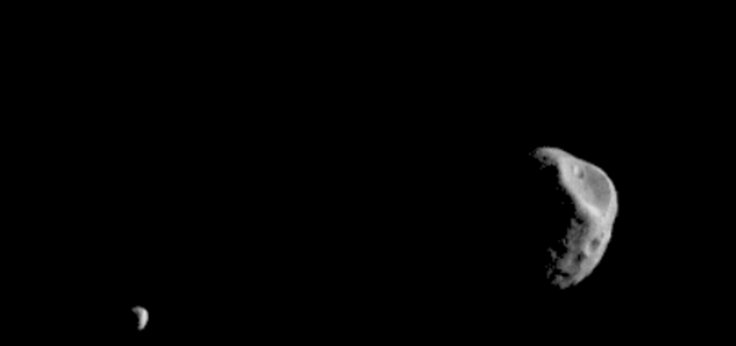
NASA's Odyssey has captured images of Mars' moons Phobos and Deimos. The space agency also released a video featuring these weird looking satellites, and interestingly, they look like potatoes plunged into deep space.
The GIF video is made up of 19 images taken by the THERMIS camera of Mars Odyssey, and the pictures used to make this clip were taken using visible-wavelength light so that human eye can view this rare sight.
"The apparent motion is due to progression of the camera's pointing during the 17-second span of the February 15, 2018, observation, not from the motion of the two moons," said NASA in a statement.
The space agency also revealed that THERMIS cameras were being used since early 2002 to observe Mars, but it was only recently that the maneuver turning the orbiter around to point the camera at Phobos was developed.
Martian moons Phobos (fear) and Deimos (panic) were named after the horses that pulled the chariot of the Greek war god Ares, the counterpart to the Roman war god Mars. Both Phobos and Deimos were discovered in 1877 by American astronomer Asaph Hall.
This is for the second time that NASA's Odyssey has taken a look at Phobos, the first time the image of Phobos was snapped on September 29, 2017. According to NASA, Phobos was just 3,489 miles away from Mars when Odyssey snapped the photograph. On the other hand, Deimos was more than 12,000 miles away when it was snapped.
For humans, the shape of Mars' satellites may seem weird, as our natural satellite Moon is exactly spherical. Phobos is 17 miles wide, and it has large craters on its surface. Deimos is just nine miles wide, and it has an array of craters on its surface which enhances its duckling-like look.
The Mars Odyssey which was launched in 2001 is surprisingly long-lived. The space agency has named this mission 'Odyssey' as a tribute to the Arthur C. Clarke sci-fi story '2001: A Space Odyssey.' The mission is managed by NASA's Jet Propulsion Laboratory in Pasadena, California. In its lifespan, it has been surveying the Martian surface and studying the minerals and chemical elements beneath it.









